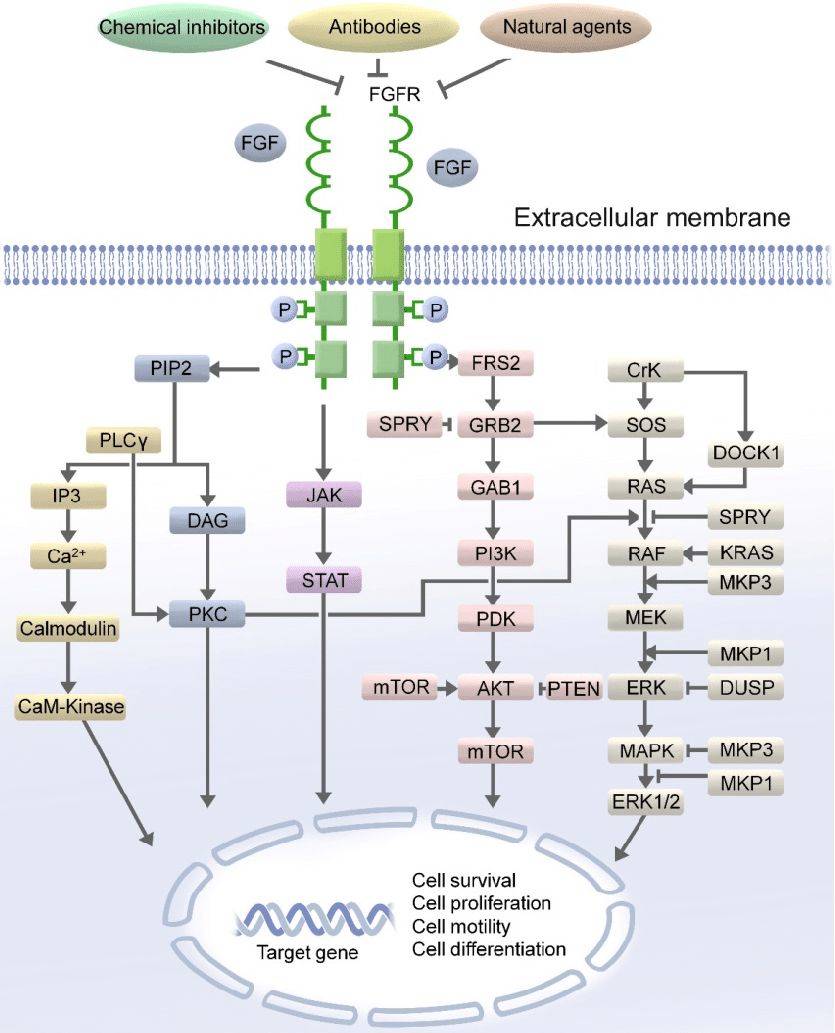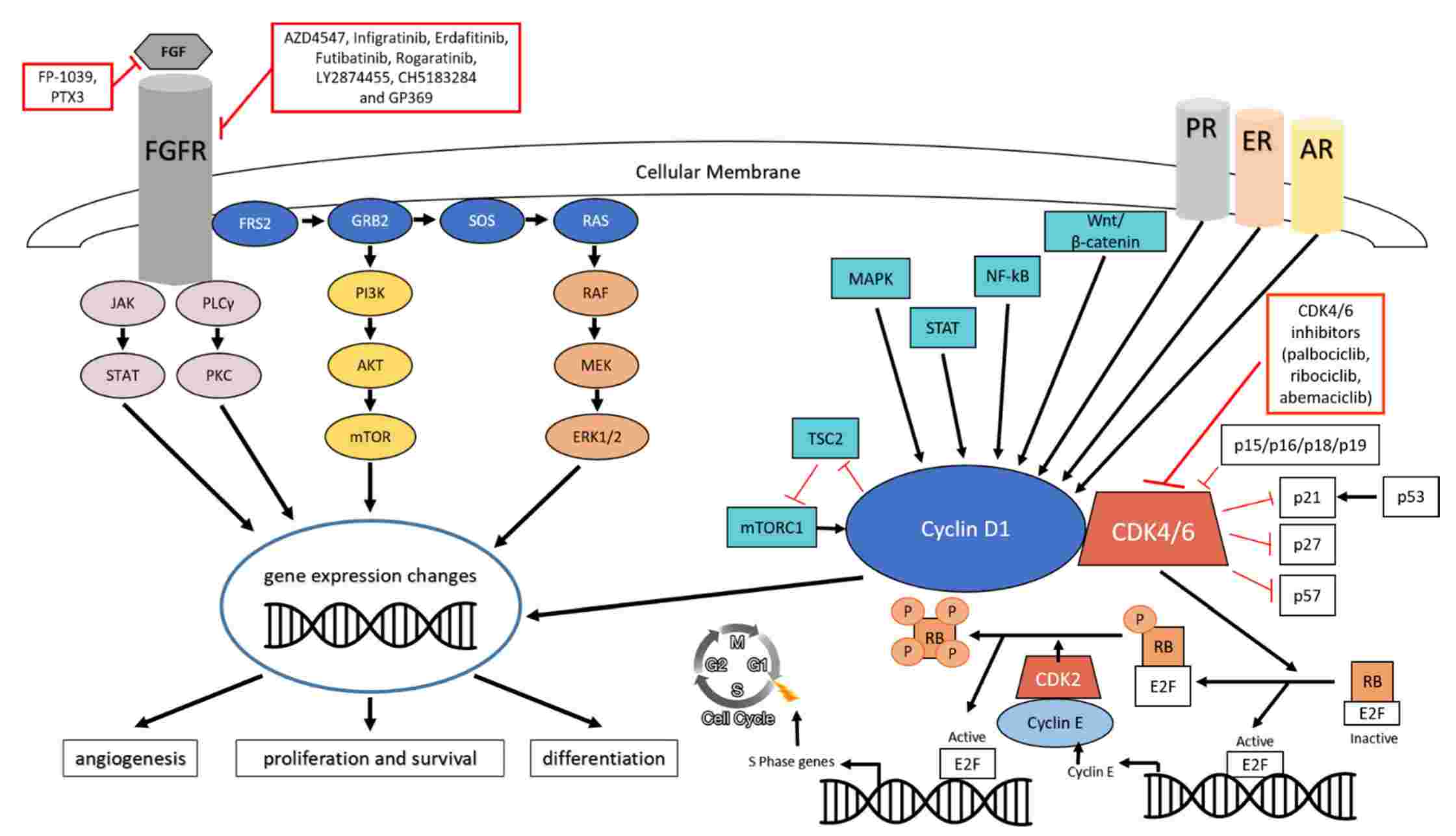FGF Receptor
Related Symbol Search List
Immunology Background
Available Resources for FGF Receptor Research
Creative BioMart is your ultimate one-stop shop for all your research needs related to FGF receptors. Our extensive range of carefully developed products and customized services are designed to help you delve deep into the world of FGF receptor molecules and their vital role in various physiological processes.
- Our product line includes top-quality recombinant proteins, protein pre-coupled magnetic beads, cell and tissue lysates, and others. We also offer a wealth of resources on FGF receptor molecules, covering essential topics such as involved pathways, protein functions, interacting proteins, related articles, and research areas.
Our Featured Products
| Cat.# | Product name | Species | Source (Host) | Tag |
|---|---|---|---|---|
| FGFR1-316H | Recombinant Human Fibroblast Growth Factor Receptor 1, His-tagged | Human | HEK293 | His |
| FGFR1OP-12879H | Recombinant Human FGFR1OP, GST-tagged | Human | E.coli | GST |
| FGFR2-87H | Recombinant Human FGFR2, His-tagged | Human | E.coli | His |
| FGFR3-6072HB | Recombinant Human FGFR3 protein, His-Avi-tagged, Biotinylated | Human | HEK293 | His-Avi |
| FGFR4-12882H | Recombinant Human FGFR4, His-tagged | Human | E.coli | His |
| Fgfrl1-2291MAF647 | Recombinant Mouse Fgfrl1 Protein, His-tagged, Alexa Fluor 647 conjugated | Mouse | HEK293 | His |
About FGF Receptors
Fibroblast Growth Factor receptors (FGFRs) are a family of transmembrane receptor tyrosine kinases that play critical roles in various cellular processes, including cell growth, proliferation, differentiation, and tissue development. They are activated by Fibroblast Growth Factors (FGFs), which are a group of signaling proteins.
The FGFR family consists of four members: FGFR1, FGFR2, FGFR3, and FGFR4. Each member shares a similar structure, comprising an extracellular ligand-binding domain, a transmembrane domain, and an intracellular tyrosine kinase domain. The extracellular domain contains three immunoglobulin-like domains (D1-D3), which are responsible for FGF binding and receptor dimerization.
The activation of FGFRs is initiated by the binding of FGF ligands. FGFs are secreted proteins that bind to the extracellular domain of FGFRs, inducing conformational changes and dimerization of the receptors. This dimerization leads to the activation of the intracellular tyrosine kinase domains, resulting in autophosphorylation of specific tyrosine residues within the receptors.
Phosphorylation of tyrosine residues creates docking sites for intracellular signaling molecules, such as adaptor proteins and kinases. These molecules then initiate downstream signaling cascades, including the mitogen-activated protein kinase (MAPK) pathway, phosphoinositide 3-kinase (PI3K)/Akt pathway, and signal transducer and activator of transcription (STAT) pathway. These signaling pathways regulate gene expression and control various cellular processes involved in cell proliferation, survival, migration, and differentiation.
FGFRs are a family of transmembrane receptor tyrosine kinases that play important roles in cellular processes and tissue development. Activation of FGFRs by FGFs leads to downstream signaling cascades, regulating various cellular functions. Dysregulation of FGFR signaling is associated with diseases, and targeting FGFRs holds therapeutic potential. Studying FGFRs enhances our understanding of cellular signaling and facilitates the development of targeted therapies.
 Fig.1 The FGF/FGFR signaling pathway. (Zhu DL, et al., 2021)
Fig.1 The FGF/FGFR signaling pathway. (Zhu DL, et al., 2021)
FGF/FGFR exhibits its physiological functions by regulating the main downstream signaling pathway, such as RAS/MAPK and PI3K/AKT/mTOR, FGF/FGFR signaling pathway could be blocked by the chemical inhibitors of FGF/FGFR, antibodies and natural agents.
Abnormalities in FGFR Signaling and Various Diseases
Abnormalities in FGFR signaling have been implicated in a range of diseases and developmental disorders. Dysregulation of FGFR signaling can arise from genetic mutations, gene amplifications, overexpression, or altered ligand-receptor interactions. Here are some examples of diseases associated with aberrant FGFR signaling:
- Cancer: FGFR alterations, including gene fusions, point mutations, and amplifications, have been identified in several types of cancer. For instance, FGFR3 mutations are commonly found in bladder cancer, while FGFR2 alterations are associated with gastric, breast, and other cancers. Aberrant FGFR signaling can drive uncontrolled cell growth, survival, angiogenesis, and metastasis in cancer cells.
- Skeletal Disorders: Mutations in FGFR3 are linked to skeletal dysplasias, such as achondroplasia, the most common form of dwarfism. Achondroplasia is characterized by impaired endochondral bone growth, resulting in short stature and skeletal abnormalities. Mutations in other FGFRs, such as FGFR1 and FGFR2, are associated with craniosynostosis syndromes, where premature fusion of skull bones occurs.
- Developmental Anomalies: Abnormal FGFR signaling during embryonic development can lead to various congenital anomalies. For example, craniofacial malformations, including cleft lip and palate, can result from disrupted FGFR signaling during facial development. FGFR mutations have also been implicated in syndromes like Apert syndrome, Pfeiffer syndrome, and Crouzon syndrome, which involve craniosynostosis and distinct facial, limb, and organ abnormalities.
- Bladder and Lung Disorders: Dysregulated FGFR signaling has been associated with bladder conditions, such as bladder overactivity and interstitial cystitis. FGFR3 mutations and increased FGFR3 expression have been observed in these disorders. In lung diseases, aberrant FGFR signaling is implicated in idiopathic pulmonary fibrosis (IPF), a progressive and fibrotic lung disease characterized by the abnormal deposition of extracellular matrix proteins.
- Angiogenesis-Related Diseases: FGFR signaling plays a crucial role in angiogenesis, the formation of new blood vessels. Dysregulated FGFR signaling can contribute to diseases associated with abnormal blood vessel growth, such as retinopathies, including diabetic retinopathy and age-related macular degeneration (AMD). In these conditions, imbalanced angiogenesis can lead to vision loss and retinal damage.
Understanding the specific FGFR alterations and their implications in different diseases is crucial for developing targeted therapies. Therapeutic approaches targeting FGFR signaling include small molecule inhibitors and monoclonal antibodies designed to inhibit FGFR activity or disrupt ligand-receptor interactions. These targeted therapies aim to normalize FGFR signaling and mitigate the pathological effects associated with aberrant FGFR activity.
 Fig.2 Fibroblast growth factor-FGF receptor (FGF-FGFR) and cyclin D-cyclin-dependent kinase (CDK)4/6 pathways in breast cancer. The molecular components of these signaling pathway and their connections are indicated, together with the available inhibitors that target FGF, FGFR, or CDK4/6. (Sobhani N, et al., 2021)
Fig.2 Fibroblast growth factor-FGF receptor (FGF-FGFR) and cyclin D-cyclin-dependent kinase (CDK)4/6 pathways in breast cancer. The molecular components of these signaling pathway and their connections are indicated, together with the available inhibitors that target FGF, FGFR, or CDK4/6. (Sobhani N, et al., 2021)
If you have any questions, requirements, or cooperation intentions, please feel free to contact us. We very much look forward to working with you and helping you achieve research and commercial success.
Related References
- Zhu DL, Tuo XM, Rong Y, Zhang K, Guo Y. Fibroblast growth factor receptor signaling as therapeutic targets in female reproductive system cancers. J Cancer. 2020;11(24):7264-7275. Published 2020 Oct 21.
- Sobhani N, Fassl A, Mondani G, Generali D, Otto T. Targeting Aberrant FGFR Signaling to Overcome CDK4/6 Inhibitor Resistance in Breast Cancer. Cells. 2021; 10(2):293.

